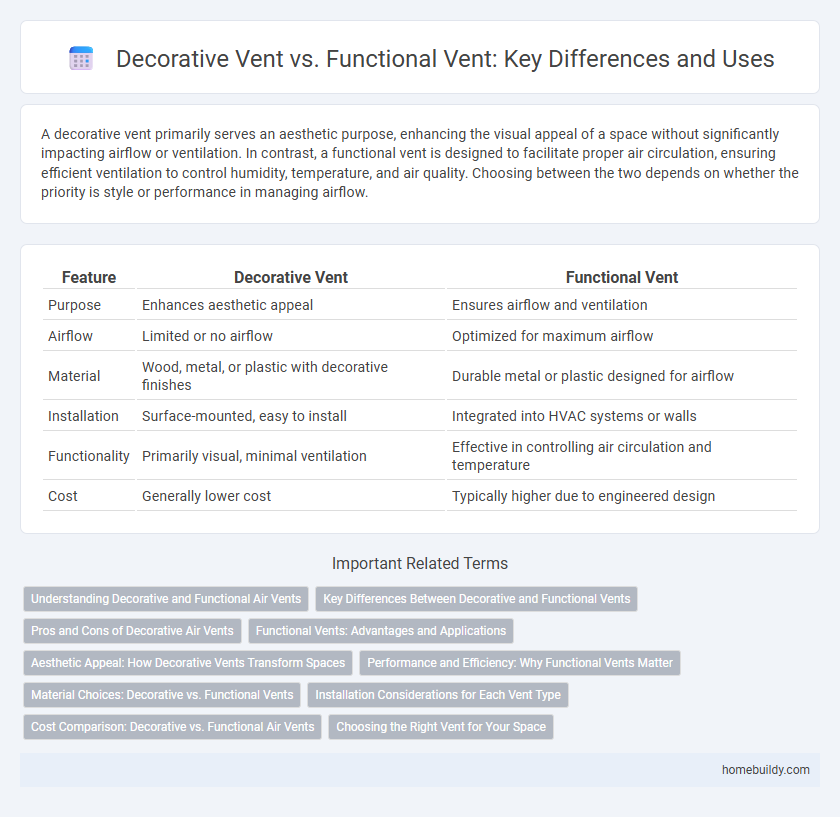A decorative vent primarily serves an aesthetic purpose, enhancing the visual appeal of a space without significantly impacting airflow or ventilation. In contrast, a functional vent is designed to facilitate proper air circulation, ensuring efficient ventilation to control humidity, temperature, and air quality. Choosing between the two depends on whether the priority is style or performance in managing airflow.
Table of Comparison
| Feature | Decorative Vent | Functional Vent |
|---|---|---|
| Purpose | Enhances aesthetic appeal | Ensures airflow and ventilation |
| Airflow | Limited or no airflow | Optimized for maximum airflow |
| Material | Wood, metal, or plastic with decorative finishes | Durable metal or plastic designed for airflow |
| Installation | Surface-mounted, easy to install | Integrated into HVAC systems or walls |
| Functionality | Primarily visual, minimal ventilation | Effective in controlling air circulation and temperature |
| Cost | Generally lower cost | Typically higher due to engineered design |
Understanding Decorative and Functional Air Vents
Decorative air vents prioritize aesthetic appeal, often featuring intricate designs and materials like wood or metal that complement interior decor while providing limited airflow. Functional air vents are engineered primarily for efficient air distribution, made from durable materials such as steel or aluminum, and designed with louvers or grilles to optimize ventilation performance. Understanding the differences helps homeowners select vents that balance airflow requirements with desired interior style, ensuring both effective HVAC operation and visual integration.
Key Differences Between Decorative and Functional Vents
Decorative vents primarily enhance the aesthetic appeal of a space with intricate designs and materials like wood or metal, lacking substantial airflow capabilities. Functional vents are engineered to regulate air circulation efficiently, often constructed from durable metals or plastics with louvers or grilles to optimize ventilation. Key differences include airflow efficiency, material durability, and design purpose, where functional vents prioritize performance and compliance with HVAC standards, while decorative vents focus on visual integration without significantly impacting ventilation effectiveness.
Pros and Cons of Decorative Air Vents
Decorative air vents enhance interior aesthetics by offering customizable designs and finishes that blend seamlessly with room decor, providing a stylish alternative to standard functional vents. However, they may compromise airflow efficiency and require more frequent cleaning or maintenance due to intricate patterns that can trap dust. Choosing decorative vents involves balancing visual appeal with potential impacts on ventilation performance in heating, ventilation, and air conditioning (HVAC) systems.
Functional Vents: Advantages and Applications
Functional vents optimize airflow in residential and commercial buildings, enhancing indoor air quality and energy efficiency by facilitating proper ventilation. They prevent moisture buildup and reduce the risk of mold growth, making them essential in attics, bathrooms, and kitchens. These vents also support HVAC system performance by maintaining balanced air pressure and temperature control throughout the space.
Aesthetic Appeal: How Decorative Vents Transform Spaces
Decorative vents enhance aesthetic appeal by blending seamlessly with interior design, often featuring intricate patterns and customizable finishes that complement decor. Unlike functional vents primarily focused on airflow efficiency, decorative vents serve dual purposes of ventilation and visual enhancement, transforming mundane spaces into stylish environments. Their installation can elevate room ambiance while maintaining effective air circulation, making them a popular choice for modern home and office interiors.
Performance and Efficiency: Why Functional Vents Matter
Functional vents prioritize airflow efficiency and temperature regulation, essential for maintaining indoor air quality and reducing energy consumption. Decorative vents, while visually appealing, often lack the necessary design features that optimize ventilation performance and can restrict airflow. Investing in functional vents ensures better performance in air exchange, humidity control, and overall HVAC system efficiency.
Material Choices: Decorative vs. Functional Vents
Decorative vents typically use lightweight materials such as plastic or thin metal alloys, which offer aesthetic appeal but may lack durability and airflow efficiency. Functional vents prioritize materials like galvanized steel, aluminum, or heavy-duty plastic to ensure optimal air circulation and long-term performance under varying environmental conditions. Choosing the right material directly impacts ventilation effectiveness, durability, and maintenance requirements in HVAC systems.
Installation Considerations for Each Vent Type
Decorative vents require precise placement to enhance aesthetic appeal without compromising airflow, often installed in less critical areas where ventilation is secondary. Functional vents demand careful positioning to ensure optimal air circulation, with installation typically involving secure mounting and proper sealing to maintain HVAC efficiency. Both vent types must consider wall or ceiling material compatibility and access for maintenance when planning installation.
Cost Comparison: Decorative vs. Functional Air Vents
Decorative air vents typically cost more upfront due to their aesthetic materials and intricate designs, averaging between $50 to $200 per vent, while functional vents prioritize affordability with prices ranging from $10 to $50. Installation costs for decorative vents may be higher, especially if customization or retrofitting is needed, whereas functional vents often fit standard openings reducing labor expenses. Over time, functional vents can save money by improving airflow efficiency and reducing energy bills, contrasting with decorative vents that primarily enhance visual appeal without impacting HVAC performance.
Choosing the Right Vent for Your Space
Choosing the right air vent for your space depends on balancing aesthetics with airflow efficiency. Decorative vents often feature intricate designs that complement interior decor but may restrict airflow, making them ideal for low-ventilation areas. Functional vents prioritize optimal air circulation and are essential in spaces requiring proper ventilation to maintain indoor air quality and temperature control.
decorative vent vs functional vent Infographic

 homebuildy.com
homebuildy.com